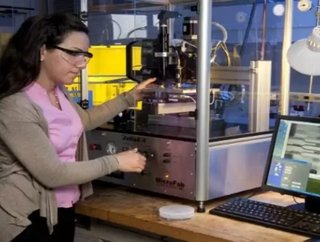Army scientists scout energy solutions for the battlefield

Image: Sarah S. Bedair, Ph.D., an electronics engineer with U.S. Army Research Laboratory, is adjusting the settings on ink-jet printer used to deposit nanomaterials onto the surfaces of micro-devices.
By Joyce P. Brayboy, U.S. Army Research Laboratory
What if scientists and engineers could scavenge energy for warfighters, like bottom feeders scavenge in the ocean?
The U.S. Army Research Laboratory, or ARL, along with the Army science and technology community, is pursuing novel technology aspects of the Army's Operational Energy Strategy.
Energy Scavenging is just one way ARL experts are getting more from existing resources, said Dr. Edward Shaffer, who is the Energy and Power Division Chief at the lab. Energy harvesting is critical to realize "net zero" energy use, a key element of the Army's Operational Energy Strategy.
There are a number of technology areas enabling operational energy, such as energy storage, alternative energy sources, high-density power converters and micro grids that the lab is pursuing.
Department of Defense operational energy is an emerging area being shaped. It is what is required to train, move, and sustain forces, weapons, and equipment for military operations. It accounted for 75 percent of all energy used by DOD in 2009, according to the Energy website for DOD.
Related story: Military Calls for Energy Innovation, Less Foreign Oil
It was in May 2011, when the Assistant Secretary of Defense for Operational Energy, Plans and Programs defined an operational energy strategy, and then published Operational Energy for the warfighter, a guide that would transform the way the DOD consumes energy in military operations.
"We want to develop technologies to enable future energy networks for the warfighter," Shaffer said. "The challenge is to develop something that could be valuable to Soldiers 15 to 20 years from now -- based on what we know today."
A past history of success in areas like electrochemistry is "informing the way forward for other technologies," he said.
"In the recent past, ARL electrochemists discovered a way to increase the duration of high-energy batteries with an electrolyte additive. Now, other teams are thinking about high-efficiency, miniature power supplies that could give small, unmanned systems bursts of power "on-demand," Shaffer said.
"Technology is ever changing," he said.
The basic research at the laboratory now will help the Army to be better in the next conflict, said John Carroll, action officer for the U.S. Army Research, Development and Engineering Command Power and Energy Technology Focus Team. "The fuel challenge won't go away. We have to fix it."
Related story: The US Army's Great Drive for Renewable Power
Shaffer originated the concept of Smart Battlefield Energy on-Demand, or SmartBED.
"SmartBED is one way we think Soldiers would be able to link up to the power they need. It will ultimately bring complex pieces together -- generator, solar systems and energy storage -- in a flexible, resilient way into an energy network," said Carroll, who retired from the Navy as a nuclear propulsion engineer before coming to ARL.
"The essence of SmartBED is being able to get energy seamlessly when and where it is needed, but yet not wasting it," Shaffer said. "Currently, we waste energy and it limits availability because often a single power source is tied directly to a single load."
We want Soldiers to plug into the energy they need to keep their sources, batteries and devices topped off, yet drawing energy only as needed," Shaffer said. "SmartBED is designed to improve energy capacity for Soldiers while they are at base camp or otherwise on the move."
Shaffer has a wide view of the energy needs across Army, DOD and interagency forums that explore complimentary ways of addressing energy and power technology gaps and reduce duplicated efforts, including the DOD Energy and Power Community of Interest and the Interagency Advanced Power Group that includes agencies like the Department of Energy and NASA.
Read more in Energy Digital: The Military Issue
These communities are comprised of scientists, engineers, subject matter experts, technologists and program managers with a common interest in promoting innovative energy and power solutions for the nation. "One of the good things is to be able to see the flow of technology and communicate at each level," Carroll said. "We come together as a science and technology community and see what investments are necessary to better get Program Executive Offices and Program Managers the operational energy tools they need when they need it."
The Army acknowledges energy and power challenges to its operational energy concept and strategy, beyond technological improvement -- there are cultural, policy and procedural concerns that leaders are addressing. There are ongoing research initiatives within the Army to explore alternatives and technology improvements in order to offset long-standing issues, like delivering large amounts of JP8 to the front lines, Carroll said. The good news is that within and beyond the Army there are partners that are finding solutions and pushing technologies ahead together more smartly, he said.
At ARL, the future is a seamless energy architecture that begins with concepts like SmartBED, Long-lived Power and Fuel-Reforming for better energy convergence.
ARL will share a series of four stories that focus on far-reaching concepts of the Army operational energy strategy. The next article in the series will focus on Smart BED. Scientists and engineers at ARL forecast solutions that empower and protect Soldiers into the future with a portfolio of basic and applied science.
SOURCE: US Army
Read More in Energy Digital's April Issue
DOWNLOAD THE ENERGY DIGITAL IPAD APP






